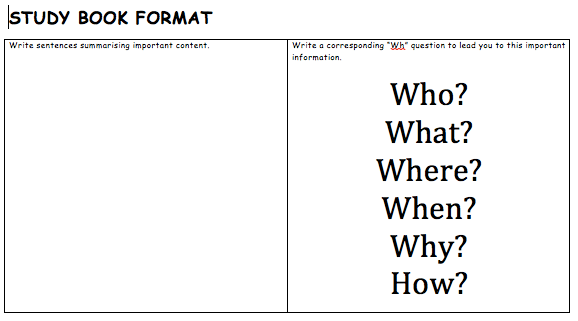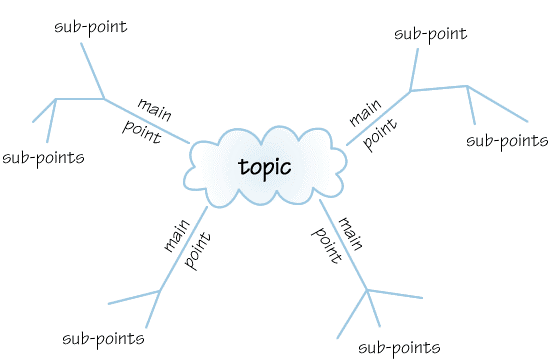
Class tests, yearly exams, and essays are all frequent aspects of life as a high school student and they rely on preparation, more commonly known as “studying”. Although students know (and are told frequently) they should go to their room and study, the act of studying and building the right study skills can be quite elusive.
One of the most common statements we hear from parents of high school students is that their child never reviews their work or doesn’t study or know how to study. Students, in reply, explain that they have no homework and hence there is nothing to study or that they don’t know what they are supposed to do.
In this article we will provide some practical tips and strategies for high school students with learning support needs to study and be greater prepared for the class tests, yearly exams and essays they face on a regular basis.
What, When, Who, What, Why & How of Studying
What is study?
Studying is different to homework that is sent home for completion overnight or by a set date. When we use the term studying we are referring to the process of summarising work covered in class, understanding this, and then doing something to remember it. Studying is not a daily task, there will be times that this is needed a lot and times when there will be no need to study.
When to study?
It is best to start studying a topic as the topic is coming to a close. Often students need to have completed the unit of work at school before connections and summaries can be created.
Who should study?
Students needs to start the process of studying themselves in the first instance. They may need some help from their classroom teacher to re-explain or clarify anything unclear after the unit has finished. Parents can also assist by being an examiner during the review process or having discussions about the topic to keep it top of mind.
What to study?
Not everything covered at school needs to be prepared into study notes and revised. However, most of the work will need this special study treatment.
For mathematics, important formulas and rules need to be summarised and reviewed on a regular basis. Although there are some great formula books available to purchase, for maximum benefit students should create their own notes with their own examples to have a mental memory of the work they have covered. Formula books and posters are a great way to supplement the student’s own notes and help pick up anything they have missed.
For English in early high school, it is often the process of learning how to write in a variety of text types (such as a newspaper article, narrative or play), how to deconstruct a poem and discussing themes and characters that are introduced. Sometimes the text being covered in class will also be included in the exam and in which case a text summary will help. Text summaries are required for later high school years.
For other school subjects the content being covered will appear in a class test or school exam. As a topic is finished, study notes should be prepared and reviewed before the test or exam. If this is an ongoing subject these notes may be required in later years and for subsequent exams.
Why study?
For a class test on one topic it is not too difficult to reread all of the notes in your school workbook as a review. However in a school exam when you have the whole year worth of work to review this is now a really big task and will probably mean that only one read can occur before the exam. Once is not enough to remember this work and be able to use it in the exam.
Study notes solve this problem. They summarize a whole section of a class workbook into one or two pages that can then easily be reviewed on a frequent basis. The greater exposures to material, the more likely this information will be stored into long-term memory and be accessible during exams.
Reading study notes in a passive way and then going on with the afternoon or evenings activities is a form of studying, but we can do so much better. Having some kind of active involvement in the study notes after they have been read will help cement this information into long term memory and is a much more accurate test of whether the student knows and can use this information in a test situation.
Building study skills
1. Review the work covered in class at the end of a topic
- Read notes from the school workbook or textbook
- Check any information that is not clear with class teacher
2. Prepare study notes
- Write or type important facts from school notes – use subheadings, list definitions, draw diagrams to summarize information, compose short sentences that summarize a whole paragraph of information
- Notes can be prepared on flashcards (paper or electronic versions), in exercise books, or typed in a computer
3. Create study questions to match notes
- For each line of study notes students should write a corresponding wh- question to check their knowledge and engage with their study notes in an active way
- E.g., Tutankhamen is the most famous pharaoh in Egypt because his tomb is the only one ever discovered intact
- Question: Why is Tutankhamen the most famous pharaoh? Whose tomb was discovered untouched?
There are also other ways to prepare study notes. Here are some examples.
Mind maps
Some students learn best using visual aids, such as drawings, maps, and pictures – so these can be great tools to build study skills. This strength can be used to create effective study notes for students, by having them represent the material they need to study in a drawing or mind map. Mind maps can be drawn by hand or using a variety of computer programs such as Mindset, Inspiration, Bubbl.
Mnemonic strategies
Rhymes, acronyms and sentences can be created to help students remember a range of frequently occurring facts, these are known as mnemonics.
Rhymes are good for spelling rules, “a piece of pie” – students should try to turn any information they are learning into a rhyme. These rhymes don’t have to make sense to anyone else but the student.
Acronyms can help reduce a list of things to remember into something more manageable to remember. Acronyms take the first letter of a number of pieces of information to create a word, usually not a real word. In Maths the trigonometric functions are remembered as SOHCAHTOA (sine opposite hypotenuse, cosine adjacent hypotenuse, tan opposite adjacent)
Lists of information can also be placed into a sentence that the student has created. Never Eat Soggy Weetbix is a way to remember the directions of the compass North East South West.
Storytelling
Related facts can also be turned into a story and by retelling the story in your mind these facts are remembered.
Revising study notes
Revising notes is a key study skill. The more times a student reads their notes the greater the chance they will remember them.
Q&A
- Reread the notes and then the student can ask themselves (or have someone else ask) the questions to check how much information they are remembering
- Highlight items that were not correct or needed a lot of thought
- Reread those the next day and ask the questions again
Review in different ways
Students who learn best aurally (hearing information) can read their study notes aloud, record these digitally (digital recorder, recording program on computer – audacity) and these can be listened to (mp3 files).
Practice papers
Use practice papers whenever they are available. Many schools keep past papers on their website to allow practice.
Motivation to study
Most students will feel unmotivated to study at some point in their life. Here are a few tips for improving study or homework motivation.
A dedicated place
Ideally your child will have a dedicated area in which to study. Good light, airflow and adequate space are needed. Where possible, remove unnecessary distractions, including magazines, TV noise or mobile phones.
Always ensure that all study materials, including books, pens, dictionaries or computers are in the study area, prior to commencing study. Searching through the school bag in the middle of study time can be distracting and frustrating.
A dedicated time
Negotiate with your child on finding a regular study time. Extra-curricular activities, dinnertime and even favourite TV programs will need to be considered. Some teenagers will prefer to come home and commence study right away, whilst others may require a break first.
Regular breaks are also very important. A quick break every 15-20 minutes is a good way to maintain concentration. This break could involve getting something to drink, stretching, doing 10 star jumps or listening to a favourite song.
Goals and rewards
Work with your child to create study goals and rewards. It’s easier to feel motivated when there is clear target to aim for and relevant rewards for achievement. Goals should be short, medium or long term. Below are some examples of goals and rewards, but remember these will vary for each individual child and family.
Daily Goal: Complete 4 x 15 minutes of study from 4pm to 5.15pm.
Daily Reward: After every 15 minutes of work there is 2 minutes of free time. At 5.15 (when the goal has been met), there should be a larger reward, such as the commencement of a favourite TV program, phone or gaming time.
Weekly/Fortnightly Goal: I will complete summarising chapter 8 by Sunday 9th October.
Weekly/Fortnightly Reward: Permission to visit a friend; see a movie; or have a family dinner.
Monthly Goal: I will have completed all chapters (1-10) before the exam on November 1st
Monthly Reward: I will feel prepared and more confident about the test. I will feel less anxious about the test. An additional reward to recognise this achievement is also suitable.
Long Term Goal: To become a teacher.
Long Term Reward: If I study hard at school, it means I may get into University and be able to be a teacher when I am older. I will feel proud and happy.
Positive approach to building study skills
If you notice your child struggling with their study skills, remind them that it is normal to have this difficulty and try to help them to pinpoint exactly what he or she is finding difficult. If you are able to find the core problem you can brainstorm solutions together or help your child to identify the best place or person to help them further.
Other strategies for helping your child to stay positive about study include:
- Teaching them to remember their past successes. This can often improve mood and remind children (and adults) that the task at hand is not impossible and they have succeeded before.
- Suggest that they visualize in their mind the next few steps they will take, Prior to study time, they might close their eyes and imagine going to their study space, getting their books ready and having a successful study session.
- Everything counts. Some study days will feel more productive than others; remind your child that every sentence they read or word written, counts.
- Keep it in perspective. If you hear your child saying “I can’t do ANYTHING,” or “Everything sucks,” remind them that this topic is just one topic out of one subject and it does not mean they are bad at everything topic, in every subject. You may even remind them that school is one part of their life, and that they still have family, friends and other extracurricular activities. Sometimes parents need to remember this too!
Addressing test anxiety
Knowing that you have prepared for a test is the best way to reduce test anxiety. Remind your child prior to an exam that they have prepared as well as they could have. Some children and adolescents suffer from significant test anxiety, in these cases visiting a psychologist can help them develop strategies to cope.
Good Luck
Building study skills is an important ability for all students to learn. It requires active learning throughout the school year, and not just at test time. Reviewing and summarising topics on a regular basis helps save time and energy at final exam time. Using creative learning and memory techniques can also be a fun and effective way to study.
For parents, providing a dedicated study area, encouraging goal setting and following through on rewards will further encourage your child to study. A positive attitude towards learning in general and a realistic balance between schoolwork and other life commitments will reduce the anxiety and distress too often associated with study. With a little support, both you and your teenager can embrace learning and stay happy.
By Dr Samantha Hornery, Education Manager
Dr Samantha Hornery is a primary and special education teacher who has worked in school and community settings teaching, developing, and managing educational programs for students with learning difficulties and disabilities. Samantha completed a doctorate in 2011 evaluating a volunteer administered reading program, Reading for Life, managed by Learning Links, a not-for-profit organisation in Sydney and was awarded the NSW Institute for Educational Research Outstanding Thesis Award in 2012. In 2014 Samantha appeared in the ABC1 documentary, Kids on Speed? helping children diagnosed with ADHD manage educational gaps in their learning. Samantha is currently Education Manager at Learning Links.




